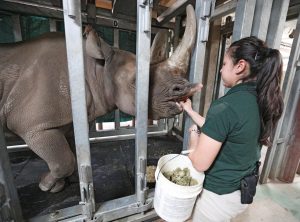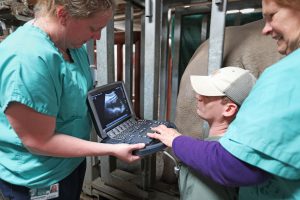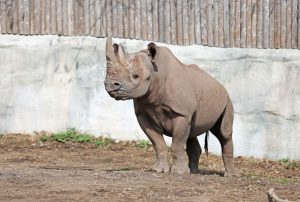 Since her arrival at Potter Park Zoo, keepers have worked with Doppsee on training a variety of behaviors useful for her daily care. Although many of her trained behaviors revolve around footwork, we have been able to utilize them for monitoring pregnancy as well. From the beginning, she has been trained to walk through a chute and to station there on daily basis, which has proven very helpful with ultrasound training.
Since her arrival at Potter Park Zoo, keepers have worked with Doppsee on training a variety of behaviors useful for her daily care. Although many of her trained behaviors revolve around footwork, we have been able to utilize them for monitoring pregnancy as well. From the beginning, she has been trained to walk through a chute and to station there on daily basis, which has proven very helpful with ultrasound training.
Before we could introduce Doppsee and Phineas for breeding, we needed to collect a variety of samples to monitor her hormone levels. By doing this, we were able to determine when she was in estrus, and when the optimal time would be to put the two rhinos together. Fecal collection required no training, however, we needed to collect urine and blood as well. Urine collection was achieved opportunistically. After a training session in the chute, Doppsee would reliably go to a specific spot in her stall to urinate. Keepers took advantage of this behavior and were able to collect a urine sample using a cup attached to a broom handle.
 Unlike fecal and urine samples, blood samples required trained behaviors. To accomplish this the rhino keepers utilized her already trained foot behaviors. When Doppsee is given the cue “foot” she moves her front foot forward and allows the keepers to assist her in placing it on a wooden block. As one keeper provides the cue and rewards her with alfalfa cubes (one of her favorite treats), our veterinary staff is able to reach her opposite leg and draw blood from the inside vein. Doppsee shows no negative response during this procedure while getting her food rewards. Currently, Doppsee has blood drawn once a week and we are able to monitor her hormone levels.
Unlike fecal and urine samples, blood samples required trained behaviors. To accomplish this the rhino keepers utilized her already trained foot behaviors. When Doppsee is given the cue “foot” she moves her front foot forward and allows the keepers to assist her in placing it on a wooden block. As one keeper provides the cue and rewards her with alfalfa cubes (one of her favorite treats), our veterinary staff is able to reach her opposite leg and draw blood from the inside vein. Doppsee shows no negative response during this procedure while getting her food rewards. Currently, Doppsee has blood drawn once a week and we are able to monitor her hormone levels.
Once we knew we would be breeding our rhinos, keepers began preparing Doppsee for rectal and transabdominal ultrasounds. During the earlier stages of pregnancy, rectal ultra-sound was the best way to see the uterus. Training for ultrasound required the keepers to get Doppsee in the chute and to close a door behind her while leaving the door in front of her open. This allows the keepers and veterinary staff to safely work behind the rhino and also allows Doppsee to leave the chute if she chooses to do so. It is important that Doppsee’s participation is always voluntary. The veterinarian can then insert the ultrasound probe into her rectum. While this is happening, Doppsee is busy eating her diet and special treats.
 In order to train for a transabdominal ultrasound, we began desensitizing her to the ultrasound machine by using a fake one while we trained. For this we used a cart with a cardboard box on it which we would place next to her for her daily training session. As she started to become more comfortable with it, veterinary staff started to work with her with the actual machine. She already responds positively to being touched, so transitioning to using the ultrasound wand on her abdomen was pretty easy.
In order to train for a transabdominal ultrasound, we began desensitizing her to the ultrasound machine by using a fake one while we trained. For this we used a cart with a cardboard box on it which we would place next to her for her daily training session. As she started to become more comfortable with it, veterinary staff started to work with her with the actual machine. She already responds positively to being touched, so transitioning to using the ultrasound wand on her abdomen was pretty easy.
All of the training we did with Doppsee was based on her willingness to participate. At any point she could choose to leave the training session and we would try again another day. Training has helped us with medical and general husbandry care and now will help us monitor Doppsee through her first pregnancy.
– Kim Hernandez
Hoofstock Lead Keeper



